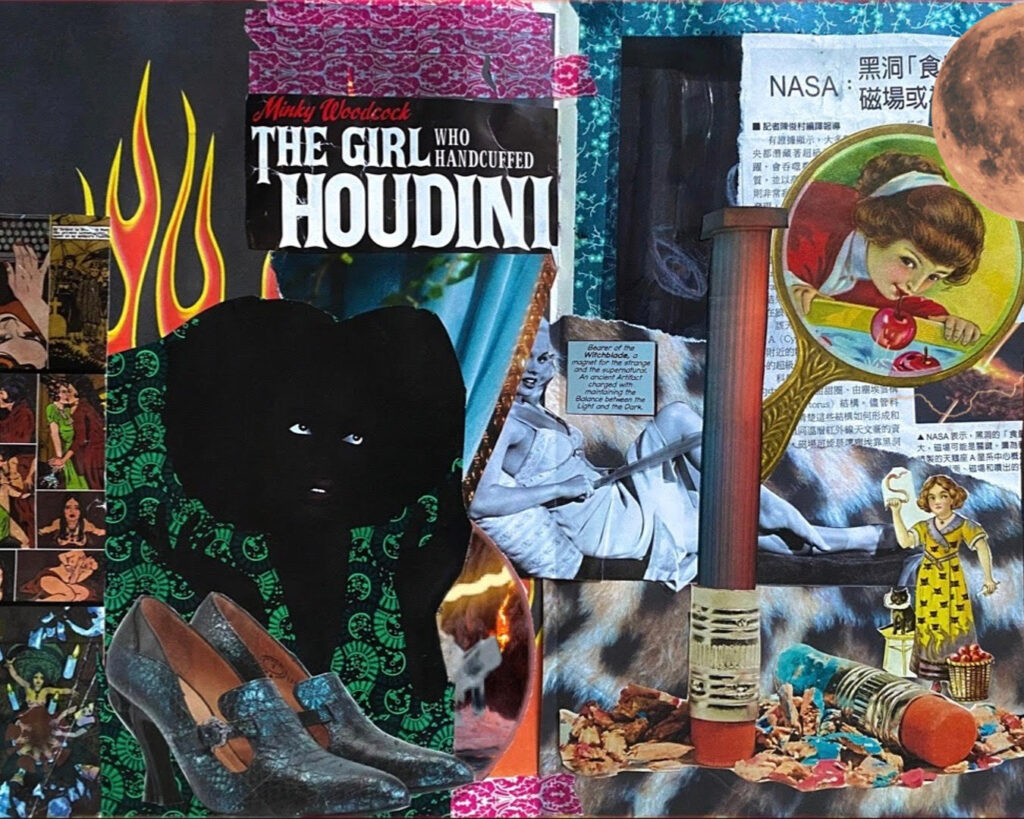
***CW for rape mentions***
Discussions of the light and dark feminine are more and more popular online. Consciously or subconsciously, women and femmes often find themselves identifying with one or the other: either you’re a child of Eve or Lilith. Either you’re a New Moon or Full Moon bleeder. Using “dark” and “light” as a descriptor creates deeper schism and conflict among people who identify with feminine energy.
I believe the light and dark feminine are artificial concepts. Which is not to say they don’t have real consequences in reality – they do. But on a spiritual level, this is a false dichotomy created by the Western patriarchy. It doesn’t naturally exist – it’s a social construct.
Feminine energy is whole on its own. The belief that it needs to be further divided is a psychic attack against the womb, women, and people who identify strongly with feminine energy. Think about it – why doesn’t the dark and light masculine exist? And if it does, why isn’t it being talked about with nearly as much fervor?
Because this is a complex topic, this will be a series. In this post, I’m focusing on how the dark and light feminine archetypes are replications of the “original sin” in the Garden of Eden story. I’m also going to break down why this story exists and what its purpose is.
Why are feminines – whether they’re “light” or “dark” – always the conduits of Truth in these stories? And why is it treated like a sin?
Duality appears to be the nature of our world; it’s required for change and progress. Without an opposing force, there’s no reason to move. Yet it’s easy for humans to demonize duality. People often see things through the lens of “me vs. the world” or “us vs. them.” Sometimes, this is a defense mechanism to keep us safe.
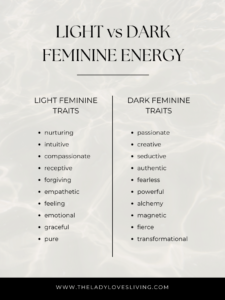
But could we all be the different people we are, a kaleidoscope of different perspectives and experiences, different lives, without this constant struggle between creation and destruction?
Could this universe be so vast and wondrous? Could all the beauty of Earth’s landscapes exist without the erosion from the wind and the water, without conflict?
Would the highs of life like love and success feel so high without the existence of the lows and the triumph of overcoming them? It doesn’t always feel good, but duality is the law of this world.
To start, I wanted to bring us back to one of the oldest known feminine entities known to modern humanity: Az-Jahi.
Az Jahi can turn you to stone with just one look (reminiscent of Medusa, right?).
She’s the “polluting whore” who caused the punishment of menstruation by opening Pandora’s box and letting evil loose (sounds awfully like Eve).
Her role is to snuff out the seed of life (sounding very Lilithian).
Clearly, Az-Jahi is aligned with what’s considered the “dark feminine” completely. She does not have a “light” counterpart to contrast her. Considering she’s one of the first known primordial mother goddesses, this feels significant.
The Zoroastrian origin story isn’t awfully different from the Abrahamic God’s creation story. Long story short, the primordial goddess Az-Jahi kissed or had sex with Ahriman, the embodiment of evil, who was asleep and unaware that goodness existed. This basically started the world as we know it – the battle between dual sides, like good and evil. (The texts’ details vary, but if she had sex with him while he was asleep, it was a rape. We’ll come back to the significance of this when we talk about Medusa.)
I believe this is a version of the Garden of Eden story. To me, it’s not about good versus evil per se, but about the introduction of duality. Before Az-Jahi’s kiss, there was only singularity, oneness. The shadow was not aware of itself yet, although it did exist. She introduced opposites. Mirrors. Knowledge of what exists outside of this singularity.
The symbols of the story are very similar to the way Lilith and Eve received knowledge in the Garden of Eden – not all of it “good,” but it’s the Truth.
I can’t talk about this topic and not mention the default Western metric of the light and dark feminine: Lilith: the barren, baby-eating, immoral seductress, and Eve: our naive, easily led astray, subjugated (apparently righteously so) mother.
Although Eve is the antidote to Lilith, both of their fates make it abundantly clear that no matter a woman’s intention, her nature is something that needs to be controlled and punished (i.e. the patriarchal view that menstruation and childbirth are punishments, both caused by Eve’s “sin”).
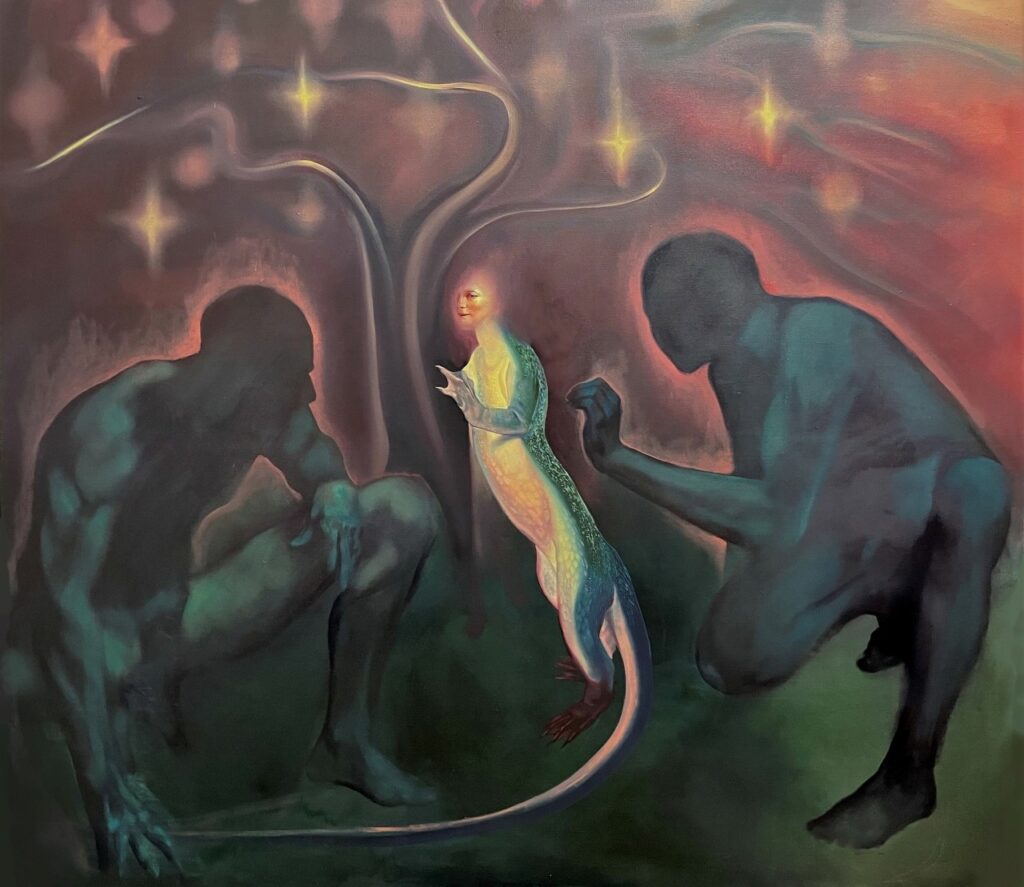
Lilith’s story is not canon in the Bible, Torah, or Koran, but is accepted in many traditions to be Adam’s first wife. Lilith appears in midrash texts – a rabbi’s interpretation of the Talmud and other religious scriptures. This means Lilith’s presence was either uncovered or inserted.
Many people attribute Lilith’s origins to Babylonian mythology, which predates the Torah. In Babylonian mythology, Lilitu are feminine demonic spirits – essentially succubi that also eat children. This is where the belief that Lilith kidnaps and eats children comes from.
Because there’s no source text to use as a foundation, it would seem “Lilith” is really a conglomerate of different projected ideas of a “bad” woman. Which isn’t to say she doesn’t exist at all. But maybe she exists to be a mirror, a shadow. To represent all the “bad” of femininity and even humanity, attributing the birth of destruction to her. Maybe she is the awareness of that previously unaware shadow.
In the case of Eve, she represents a separation of the more palatable, nurturing (creation) side of feminine energy, mixed with patriarchal distortions as a means to control this energy.
But you can’t truly separate feminine energy. Eve ate from the garden anyway – she was always going to. I find it hard to believe there’s a reality where she and Adam remained in the Garden of Eden forever. If God is all-knowing, I can’t imagine He didn’t know this was futile.
It’s very similar to Ahriman’s state of unconsciousness before Az Jahi’s kiss – duality existed, but it was hidden. That “forbidden” knowledge represented by the fruit always existed. Eve and Adam were just unaware of it. But without that awareness, there would be no duality – only stagnation.
In the Book of Genesis is the story of Abraham, Sarah, and Hagar. This story is prolific in Judaism, Islam, and Christianity because this is where the branching off between the three religions essentially began. Sarah (Abraham’s first wife) and Hagar (Abraham’s handmaiden or second wife) are clear embodiments of the light and the dark feminine distortions.
Many Christian and Jewish texts describe Hagar as a “servant,” “slave,” or even “concubine.” The fact that she was a “foreigner” is sometimes mentioned negatively. Islamic texts tend to use more elevating language to describe her, emphasizing that she was Abraham’s second wife. (This is due to the fact that her son, Ishmael, is considered to be one of their prophets.) Some Jewish texts acknowledge this as well. She’s even rumored to be the daughter of a Pharaoh, given as a gift to unite the Jew and Egyptians. Like Lilith, Hagar’s story can’t be taken at face value because so many people project their societal judgments on her.
It’s my personal belief that Hagar was a highly esteemed priestess of Hathor, tasked with being a surrogate as her duty. Hagar demonstrated that she could divine. I don’t think it’s a coincidence that she, apparently a woman of no power or knowledge, was the first person in Christian scripture to speak to God and even give him a name: “El Roi.” Or, “God who sees me.” Very relevant and astute considering how many people are still judging Hagar today, to the point of her identity being unclear to many.
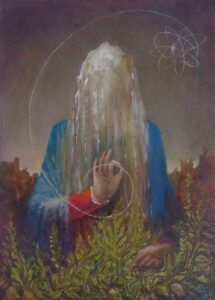
Sarah treated Hagar poorly – no text denies that. Some versions of the story try to justify this behavior by claiming Hagar was ungrateful or vindictive. But that seems to be a human reaction to doing something as noble as carrying a child for someone else and being treated like a slave. (I stopped watching The Handmaid’s Tale, but this reminds me of the dynamic between Offred and Serena Joy in S2.)
And yet, for being the faithful (first) wife, for patiently waiting, for having to “put up with” another woman in her house, Sarah is rewarded with conception – finally. Hagar and her son are cast away. Sarah is upheld as an archetype of the ideal woman – essentially a ride-or-die.
This sounds like propaganda for control, to me. You have to think — what was preventing these two women with the same goal from working together?
The connection between Athena and Medusa is so complex that it needs its own post (which is in the works). But for now let’s suffice it to say that Medusa is the “dark feminine” counterpart of Athena.
Returning to Az Jahi’s potential rape of Ahriman – I’m not convinced that Medusa was raped by Poseidon.
I don’t mean this in a victim-blaming way. With religious stories and myths, acts are more than just acts. Sometimes these acts are symbols concealing information. Also, think about how the white patriarchy has weaponized rape to their advantage throughout history, especially against indigenous people. I’ll explain what I mean.
Ancient Greek mythology is largely stolen from other ancient traditions that already existed. Many ancient societies, particularly non-European ones, deeply revered nature. The Greeks did not – not nearly to the same degree. Many non-European gods are deifications of the forces of nature. The Greeks did have primordial nature gods that were lifted from other traditions (like the ancient Egyptians), but overall they wanted their gods to more resemble their society and human affairs (masculine concept) versus nature and the Earth’s cycles (feminine concept). Because that’s what their society valued, and also because they probably didn’t want to admit that nature can’t be controlled. Society can. Think about how uncontrollable their nature gods are – like Zeus. So we have to examine their myths with this in mind. This means the foundation of Greek mythology is essentially masculine and imbalanced.
So with all that said, think about the phrase “as above, so below.” Think about how the waters reflect the heavens. Indigenous non-European people largely associate the ocean with the collective consciousness and womb. It’s a source of potent power and creation. And it intelligently reflects both the state of the heavens and the state of the collective consciousness of Earth.
Now. The Greek god in charge of all this had sex with a mortal and it transformed her permanently. Is this not another Garden of Eden story?
And do you understand why the Greeks would call this a rape? They believed she had no business getting so close to a god, let alone an uncontrollable nature god. They thought she had no right to have access to that information.
Medusa the “monster” was still mortal but had unimaginable powers. Not only was her gaze a weapon, but her blood healed all wounds. She had the capacity to both kill and heal, and people stole those powers from her despite the fact that she wasn’t messing with anybody.
Again, why is an enlightened feminine portrayed as a perversion that must be conquered and controlled?
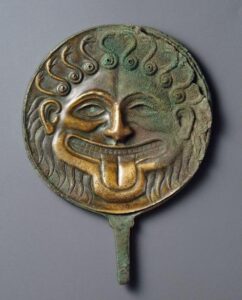
The symbolism of Medusa’s beautiful hair turning into snakes is also an obvious reference to the Garden of Eden, especially considering why it happened. Western interpretations of the snake attribute it to the original sin of the Garden of Eden: deception, disobedience.
But other interpretations of the snake include wisdom, especially in the form of axis mundi – a direct connection to “as above, so below” and the way spiritual knowledge is transmitted. Snakes are also related to the caduceus symbol, which represents healing (which is why it’s known as the symbol for the healthcare industry). The caduceus belongs to Mercury, the messenger of the gods — and Mercury rules over the process of thought in astrology. It’s pretty clear to me that Medusa had access to knowledge that no human “should” — which is why her powers were so sought after.
An aside – I never understood why the anime Soul Eater had a character named Medusa totally unlike the Greek figure. She was a mad scientist archetype, stopping at nothing to get the knowledge she sought after. This portrayal makes total sense to me now.
Feminine energy is inherently destructive – period. There are no light feminines whose only purpose is to nurture and heal. Similarly, those who associate with the dark feminine should not internalize that everything they touch they destroy, because they also have a great capacity to heal.
These energy descriptors are only relevant to certain traditions with deities that specifically represent the destructive aspects of femininity. But they are ultimately representing a force or law of nature – not a human person.
All people regardless of gender have these capabilities and more because all people have both feminine and masculine energy.
You miss out on a lot by only identifying with one part of your feminine energy – it’s only half of an understanding.